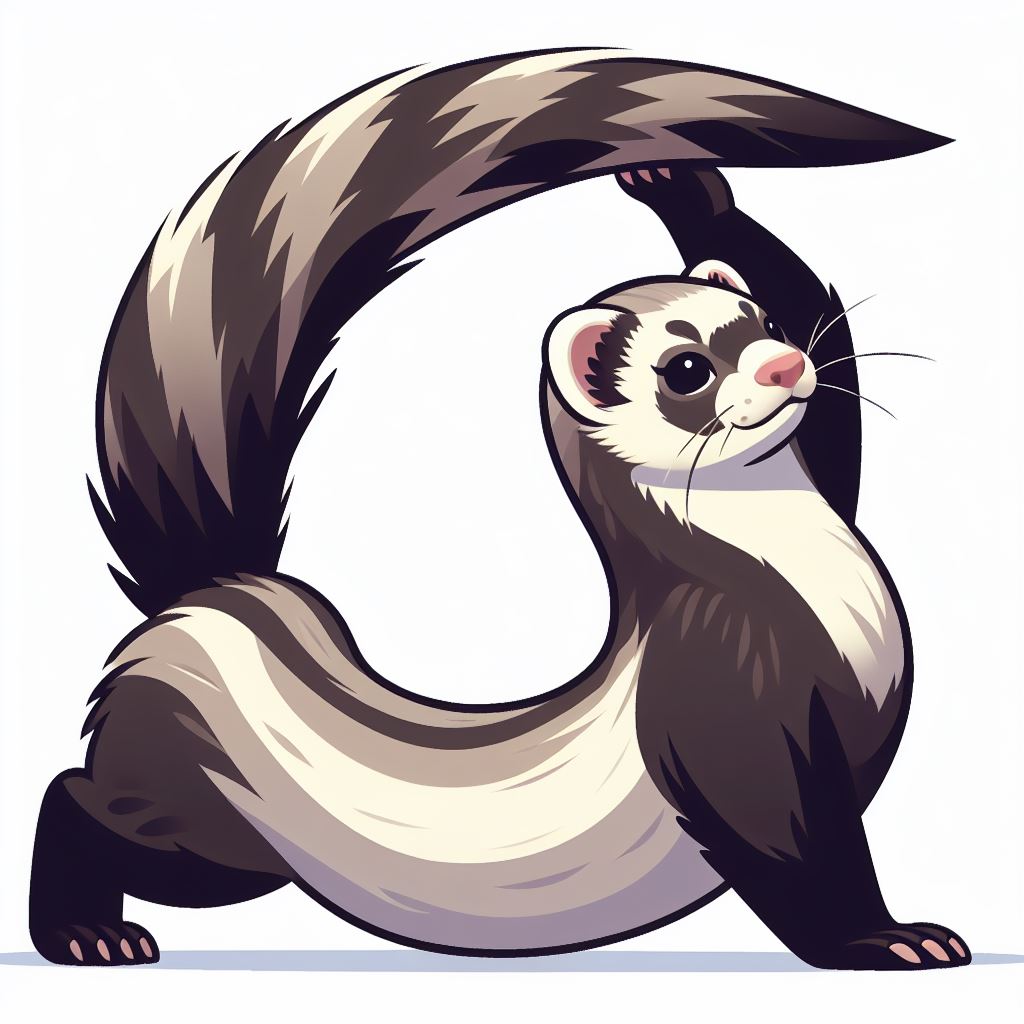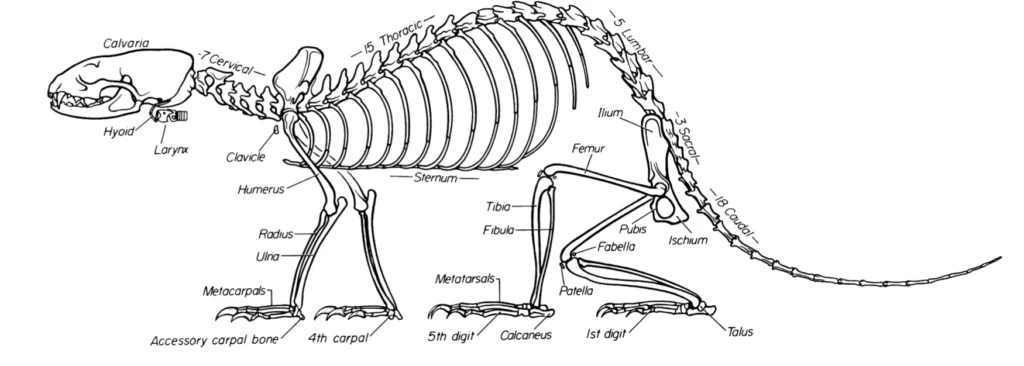Do Ferrets Have Spines? Understanding Ferret Anatomy

Yes, Ferrets have spines that has a lot of flexibility and relatively large in size. The length of the spinal cord in ferrets is approximately 30 to 35 cm.
The function of the spinal cord in ferrets is to transmit nerve signals between the brain and the rest of the body. It serves as a pathway for sensory information to travel from the body to the brain and for motor commands to travel from the brain to the muscles, enabling movement and coordination.
The spinal cord plays an important role in reflex actions, such as pulling away from a painful stimulus without conscious thought.
Ferrets can easily perform twisting and turning movements due to the flexibility of their spine. This flexibility allows them to navigate tight spaces, exhibit agility in their movements, and chase prey through small holes or burrows, showcasing their ability to move swiftly and with precision
Topics Covered In The Article
- Understanding Ferrets Anatomy
- How Does The Ferret’s Spine Allow For Their Flexibility?
- What Are Some Other Ways That Ferrets Use Their Spine Besides Hunting Or Catching prey?
- What Are the Potential Signs Of Spinal Problems In Ferrets?
- Common Spinal Problems In Ferrets
- How To Prevent Spinal Problems In Ferrets?
Understanding Ferrets Anatomy

What Is The Structure Of A Ferret’s Spine?
To understand the structure of the ferret’ spine we have to look at it’s various parts that can include things such as:
- Vertebral Formula: The vertebral formula of a ferret is C7, T15, L5 (6 or 7), S3, Cd18. This indicates the number of vertebrae in each section of the spine – cervical (neck), thoracic (chest), lumbar (loin), sacral, and caudal (tail) regions
- Cervical Region: The neck of a ferret is long, with seven cervical vertebrae that are more massive than the thoracic vertebrae. The cervical musculature is well-developed to support movement and stability of the head and neck during hunting activities.
- Thoracic Region: Ferrets typically have 15 thoracic vertebrae characterized by paired ribs. Each rib consists of a bony costal portion and a cartilaginous sternal portion, supporting the rib cage and facilitating breathing.
- Lumbar Region: The lumbar region of a ferret consists of five, six, or seven lumbar vertebrae that increase in size from the first to the last. These vertebrae contribute to the flexibility and movement of the ferret’s spine, supported by a well-developed trunk musculature.
- Sacral Region: In the sacral region, the three sacral vertebrae are fused into one mass. The sacrum plays a vital role in connecting the spine to the pelvis and supporting the hind limbs.
- Caudal Region: The caudal region of a ferret’s spine consists of 18 caudal vertebrae, making up the tail. These vertebrae aid in balance and movement, with the tail being densely furred and assisting in swimming.
How Does The Ferret’s Spine Allow For Their Flexibility?
The flexibility of the ferret spine is facilitated by its structure, particularly the presence of numerous vertebrae and the design of the vertebral column. The ferret’s spine consists of different regions with varying numbers of vertebrae, such as cervical, thoracic, lumbar, sacral, and caudal regions.
This segmentation allows for a greater range of motion and flexibility in different parts of the spine. Additionally, the long and slender body shape of ferrets contributes to their ability to twist and turn easily due to the elongated vertebral column.
The absence of rigid connections between vertebrae and the presence of specialized joints enable the spine to bend and flex smoothly, supporting the agility and nimbleness observed in ferrets.
What Are Some Other Ways That Ferrets Use Their Spine Besides Hunting Or Catching prey?
Apart from hunting and catching prey, ferrets utilize their flexible spine in various other activities. One notable use of their spine is in burrowing and navigating through tight spaces, which is essential for their natural behavior of exploring and creating underground tunnels.
Ferrets employ their flexible spine in playful activities, such as twisting, turning, and contorting their bodies during interactive play with toys or other ferrets. This flexibility also aids in their agility and balance, allowing them to climb, jump, and explore their surroundings with ease.
Overall, the adaptability of their spine enables ferrets to engage in a range of movements and behaviors beyond hunting, contributing to their active and curious nature
What Are the Potential Signs Of Spinal Problems In Ferrets?
Some signs that a ferret may be developing spinal problems include:
- Pain: Ferrets may exhibit signs of pain, such as reluctance to move, hunching their back, or vocalizing when touched.
- Weakness: Spinal issues can lead to weakness in the hind legs or overall reduced mobility.
- Paralysis: In severe cases, spinal problems can cause partial or complete paralysis in the hindquarters.
- Changes in Behavior: Ferrets with spinal problems may show changes in behavior, such as decreased activity levels or reluctance to engage in normal activities.
Common Spinal Problems In Ferrets
Some common spinal problems in ferrets include intervertebral disc disease, which can lead to pain, weakness, and paralysis due to disc herniation or degeneration.
- Intervertebral Disc Disease: This condition in ferrets can lead to pain, weakness, and paralysis due to disc herniation or degeneration. It affects the discs between the vertebrae, causing neurological issues and impacting the ferret’s mobility1.
- Spinal Trauma: Spinal trauma from accidents or falls can result in fractures or dislocations of the vertebrae in ferrets. These injuries can lead to neurological problems and affect the ferret’s ability to move properly, requiring veterinary attention for diagnosis and treatment
How To Prevent Spinal Problems In Ferrets?
The preventive measures for spinal problems in ferrets include providing a safe environment to prevent accidents or falls that could lead to spinal trauma. Maintaining a healthy weight through proper nutrition can help reduce the risk of intervertebral disc disease, a common spinal issue in ferrets.
Regular veterinary check-ups and prompt treatment of any signs of discomfort or mobility issues can also aid in early detection and management of potential spinal problems in ferrets
Last Updated on 20 March 2024
Waman Nuka is a seasoned wordsmith and a passionate animal enthusiast with decades of experience in the world of animal care. With a deep love for all creatures great and small, Waman’s journey in the realm of animals started as a young boy exploring the lush forests surrounding his childhood home.


